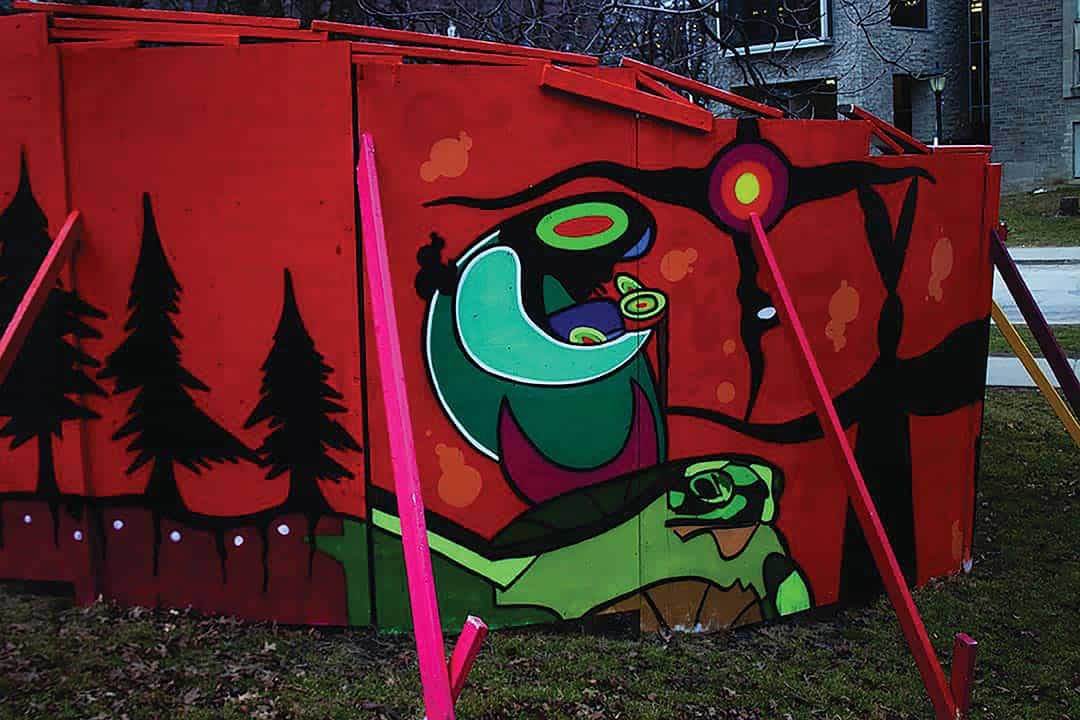Content warning: This article contains a brief discussion of residential school graves.
In recent years, U of T has seen more and more artwork by Indigenous peoples on campus. Each piece expresses a variety of techniques and ideas that welcome students to engage with Indigenous Knowledge.
In a conversation with The Varsity, Mikinaak Migwans, an Anishinaabekwe art historian and professor at U of T, spoke about a variety of Indigenous art installations that exist at U of T.
Migwans is most closely affiliated with the tree protection zone project at Hart House. The project was made in collaboration with Maria Hupfield, a colleague of Migwans’, and Anishinaabe artist Susan Blight. This piece, which allowed the artists to use their street art skills, is a temporary installation and will be replaced by an Indigenous garden in the future.
Migwans expressed enjoyment that the work took place outdoors and in nature. “It was an ephemeral site on these construction hoardings, so it’s not a traditional gallery site,” they expressed. “It was really nice to work on campus outside and engage with some of the non-human communities around — the trees and all the occupants of the trees.”
The second piece Migwans discussed was the Solomon and Trinh King piece that U of T commissioned for the Myhal Centre for Engineering Innovation & Entrepreneurship. It’s a multimedia project, including bead and wood work.
The piece pays homage to natural entities on earth that display engineering feats, such as honeycombs. Migwans explained that this piece does a great job demonstrating that nature is not just an entity that we should observe, but one that we should work in collaboration with — a common theme in Indigenous Knowledge.
“It shows us how Indigenous Knowledge can be a part of our educational experience… [it is] something that should be integrated into our practices as we become professionals,” said Migwans. They added that Indigenous Knowledge is often factored out in the Canadian education system. The piece is a reminder that we should be integrating Indigenous Knowledge into our curriculums.
Migwans then spoke about the Great Hall at Hart House, which houses several pieces of art that depict the different individuals who have been at the top of the university’s hierarchical structure. There is a clear lack of diversity and representation among these individuals.
“It’s very evident… the race and gender dynamic of that power structure,” Migwans said. “Waabidiziiyan doopwining,” or “to see oneself at the table,” created by Rebecca Belmore and Osvaldo Yero, is a mirror piece that now resides in the Great Hall among the portraits of past U of T presidents. Migwans explained that this piece is a significant response to what already existed in the Great Hall. Instead of simply adding a diverse portrait for ‘representation,’ which is often the automatic response to and a quick fix for lack of diversity, this piece of art is a mirror, so that everyone can see themselves represented.
The next piece Migwans described was the Daniels Mural Project by Que Rock, a multimedia artist who used his aerosol skills to create the piece. The mural is displayed on a window of the Daniels Faculty of Architecture, Landscape, and Design so that it can be visible to passersby at any time.
The project is a response to U of T’s Truth and Reconciliation Commission’s report. According to the report, “A strategy for the funding and placement of more Indigenous public art across all three campuses should be developed, in close consultation with local Indigenous communities.” The piece was also created to recognize the unmarked graves of 215 children confirmed in Kamloops, British Columbia, in 2021. Canada’s National Truth and Reconciliation Commission has concluded that at least 4,100 students died while attending residential schools, the last of which closed in 1997.
Migwans concluded that diversity in art should not only make sure that everyone feels represented and supported, but that it must also address ongoing systems of exclusion. “[We have to] make sure that we’re not just talking about the representation of diversity… but people’s lives — making sure that our people are being treated like community members.”


